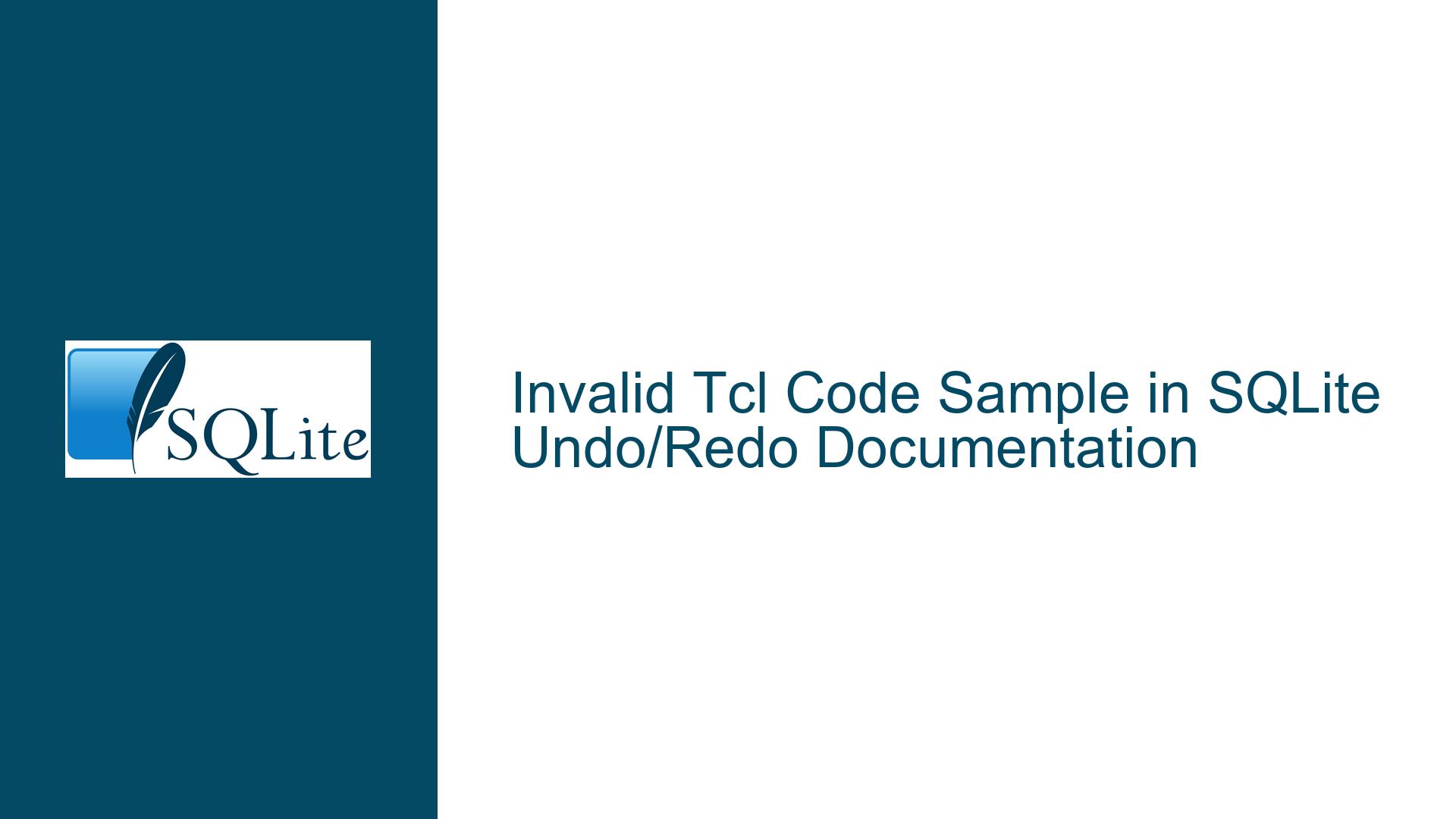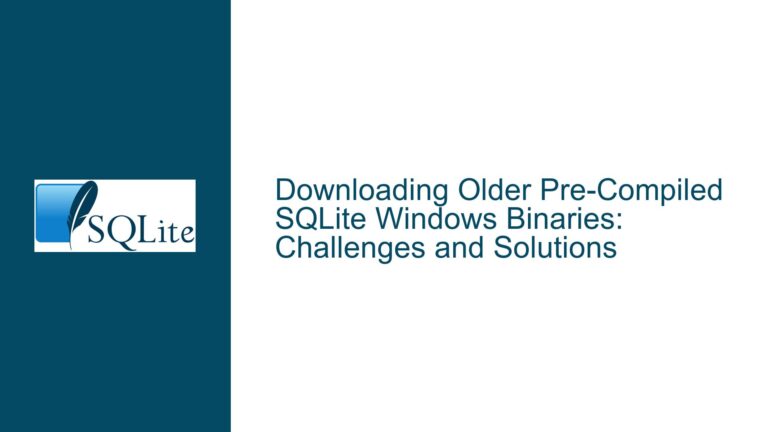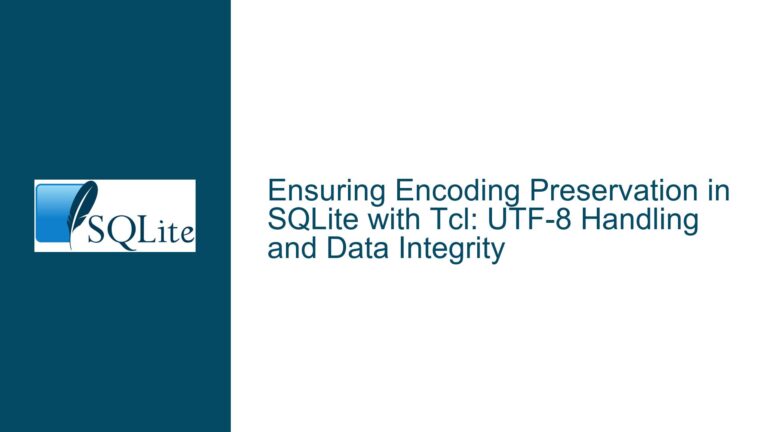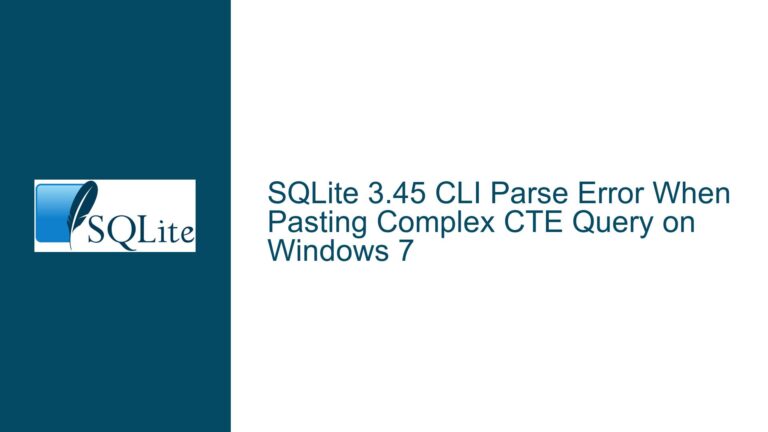Invalid Tcl Code Sample in SQLite Undo/Redo Documentation
Issue Overview: Invalid Tcl Code Sample in SQLite Undo/Redo Documentation
The core issue revolves around an invalid Tcl code sample provided in the SQLite documentation related to the undo/redo functionality. The code snippet is intended to demonstrate how to implement a "freeze" mechanism within a Tcl-based undo/redo system. However, the code contains syntax errors, logical inconsistencies, and improper usage of SQLite’s Tcl interface, rendering it non-functional. The problematic code is as follows:
proc freeze {} {
variable _undo
if {!}; hd_resolve_one {info exists _undo(freeze)}; hd_puts {}
return if {$_undo(freeze)>=0} {error "recursive call to ::undo::freeze"}
set _undo(freeze)
};
hd_resolve_one {db one {SELECT coalesce(max(seq),0) FROM undolog}};
hd_puts { }
The code is intended to perform the following tasks:
- Check if the
_undo(freeze)variable exists and is properly initialized. - Prevent recursive calls to the
freezeprocedure by throwing an error if_undo(freeze)is already set. - Set the
_undo(freeze)variable to a specific value. - Execute a SQL query to retrieve the maximum sequence number from the
undologtable.
However, the code fails to achieve these objectives due to several issues, including:
- Missing or misplaced semicolons and braces.
- Incorrect usage of the
hd_resolve_oneandhd_putscommands. - Logical errors in the conditional statements.
- Improper handling of the
_undoassociative array.
These issues make the code unusable as-is and could lead to confusion or errors for developers attempting to implement similar functionality.
Possible Causes: Syntax Errors, Logical Inconsistencies, and Misuse of Tcl Commands
The invalid Tcl code sample can be attributed to several underlying causes, which are explored in detail below.
Syntax Errors in Tcl Code
The most immediate issue with the code is its syntax. Tcl is a string-based language where commands are separated by newlines or semicolons, and blocks of code are enclosed in braces. The provided code contains several syntax errors, including:
- Missing semicolons or newlines between commands.
- Improperly nested braces, leading to unbalanced code blocks.
- Misplaced or missing braces in conditional statements.
For example, the line if {!}; hd_resolve_one {info exists _undo(freeze)}; hd_puts {} is syntactically incorrect. The if command expects a condition followed by a body, but the condition {!} is incomplete, and the body is missing. Similarly, the return command is incorrectly placed within the if statement, leading to a logical error.
Logical Inconsistencies in the Freeze Mechanism
The code attempts to implement a "freeze" mechanism to prevent recursive calls to the freeze procedure. However, the logic is flawed. The condition if {$_undo(freeze)>=0} is intended to check if the _undo(freeze) variable is already set, but the variable is not properly initialized or checked before this condition is evaluated. This could lead to runtime errors or unexpected behavior.
Additionally, the set _undo(freeze) command is incomplete. It does not specify a value to assign to _undo(freeze), which is necessary for the freeze mechanism to function correctly.
Misuse of hd_resolve_one and hd_puts Commands
The hd_resolve_one and hd_puts commands are used in the code, but their usage is incorrect. These commands are typically used in the context of generating HTML documentation, not in Tcl scripts interacting with SQLite. The hd_resolve_one command is used to resolve a single value from a SQL query, but it is not properly integrated into the Tcl script. Similarly, the hd_puts command is used to output text, but its placement and usage in the code are inappropriate.
Improper Handling of the _undo Associative Array
The _undo associative array is central to the undo/redo functionality, but it is not properly handled in the code. The array is declared using the variable command, but its elements are not initialized or checked correctly. For example, the info exists _undo(freeze) command is used to check if the _undo(freeze) element exists, but the result of this check is not used in any meaningful way. This could lead to runtime errors if the _undo(freeze) element is accessed before it is initialized.
Troubleshooting Steps, Solutions & Fixes: Correcting the Tcl Code Sample
To address the issues in the Tcl code sample, the following troubleshooting steps, solutions, and fixes are recommended.
Step 1: Correcting Syntax Errors
The first step is to correct the syntax errors in the code. This involves ensuring that commands are properly separated by semicolons or newlines, and that braces are correctly nested. The corrected code should look like this:
proc freeze {} {
variable _undo
if {![info exists _undo(freeze)]} {
hd_puts {}
return
}
if {$_undo(freeze) >= 0} {
error "recursive call to ::undo::freeze"
}
set _undo(freeze) 1
}
In this corrected version:
- The
ifcommand is properly structured with a condition and a body. - The
returncommand is placed outside theifstatement to ensure proper flow control. - The
setcommand is completed with a value assignment.
Step 2: Fixing Logical Inconsistencies
The next step is to fix the logical inconsistencies in the freeze mechanism. This involves properly initializing and checking the _undo(freeze) variable before using it. The corrected code should include proper initialization and checks:
proc freeze {} {
variable _undo
if {![info exists _undo(freeze)]} {
set _undo(freeze) -1
}
if {$_undo(freeze) >= 0} {
error "recursive call to ::undo::freeze"
}
set _undo(freeze) 1
}
In this corrected version:
- The
_undo(freeze)variable is initialized to-1if it does not already exist. - The condition
if {$_undo(freeze) >= 0}is used to check if the variable is already set, preventing recursive calls.
Step 3: Properly Using hd_resolve_one and hd_puts Commands
The hd_resolve_one and hd_puts commands should be removed from the Tcl script, as they are not appropriate for this context. Instead, the script should use standard Tcl commands to interact with SQLite. The corrected code should look like this:
proc freeze {} {
variable _undo
if {![info exists _undo(freeze)]} {
set _undo(freeze) -1
}
if {$_undo(freeze) >= 0} {
error "recursive call to ::undo::freeze"
}
set _undo(freeze) 1
}
In this corrected version:
- The
hd_resolve_oneandhd_putscommands are removed. - The script uses standard Tcl commands to interact with SQLite.
Step 4: Properly Handling the _undo Associative Array
The _undo associative array should be properly handled to ensure that its elements are correctly initialized and checked. The corrected code should include proper initialization and checks for the _undo(freeze) element:
proc freeze {} {
variable _undo
if {![info exists _undo(freeze)]} {
set _undo(freeze) -1
}
if {$_undo(freeze) >= 0} {
error "recursive call to ::undo::freeze"
}
set _undo(freeze) 1
}
In this corrected version:
- The
_undo(freeze)element is initialized to-1if it does not already exist. - The condition
if {$_undo(freeze) >= 0}is used to check if the element is already set, preventing recursive calls.
Step 5: Integrating SQLite Query Execution
The final step is to integrate the execution of the SQL query to retrieve the maximum sequence number from the undolog table. This should be done using standard Tcl commands to interact with SQLite. The corrected code should look like this:
proc freeze {} {
variable _undo
if {![info exists _undo(freeze)]} {
set _undo(freeze) -1
}
if {$_undo(freeze) >= 0} {
error "recursive call to ::undo::freeze"
}
set _undo(freeze) 1
set max_seq [db one {SELECT coalesce(max(seq),0) FROM undolog}]
return $max_seq
}
In this corrected version:
- The SQL query is executed using the
db onecommand to retrieve the maximum sequence number from theundologtable. - The result of the query is stored in the
max_seqvariable and returned by thefreezeprocedure.
Conclusion
The invalid Tcl code sample in the SQLite undo/redo documentation can be corrected by addressing syntax errors, logical inconsistencies, and improper usage of Tcl commands. The corrected code should properly initialize and check the _undo(freeze) variable, use standard Tcl commands to interact with SQLite, and execute the necessary SQL query. By following the troubleshooting steps and solutions outlined above, developers can implement a functional freeze mechanism within a Tcl-based undo/redo system.






